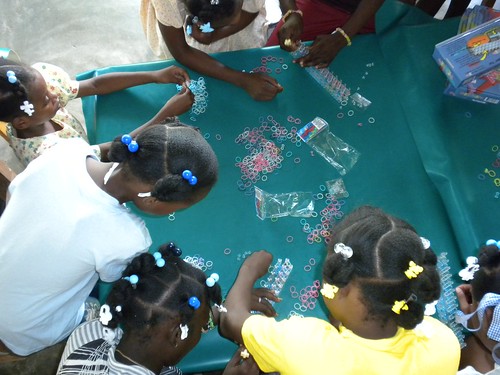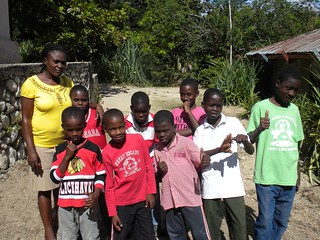Haiti Mission Trip – Paul
Jennings Reflections
October 2013
Forest Hill Church
From the beginning I was
wondering what to expect from this mission trip. I assumed we were coming to help the
people. The entire trip was only 8 days
in length. I felt like maybe we should
schedule more work and less tourism. A previous mission trip was conducted by
FHC in the spring of 2012 to try to determine which organizations we should
partner with, in order to be more effective in our attempts to help the people
of Haiti. On this latest trip we worked
with a local group called the Little Brothers and Little Sisters of the
Incarnation.
When people ask, “what was
it like?” so many thoughts come to mind that it is hard to decide what to
say. Haiti is the poorest country in the
western hemisphere. They suffered
massive destruction in the 2010 earthquake and are still in the process of
recovering from that event. Joshua, one
of our translators, told us that the majority of people in Haiti eat only one
meal a day. There are so many outside
groups in Haiti trying to help, and apparently their track record is a bit
mixed. This makes it all the more
important that we be vigilant in figuring out who we should be working with.
Much progress has certainly
been made in rebuilding. Visible signs
of the earthquake damage have been dramatically reduced. There are vibrant sidewalk shops everywhere,
selling all types of food and other goods.
The clothing and artwork are very colorful. There are many signs of how industrious,
clever and hard-working the people are. Although
most people are walking, there are also motorcycles used as taxis and small
pickup trucks with two benches and a cover in the back, that are used in lieu
of buses. Donkeys and horses are
frequently used to haul things and people will often carry sizable loads on top
of their head. I suspect that this
results in strong bones and very good posture!
We could use some of the health benefits of more walking, back here in
the US.
We spent two days in the
Port-au-Prince area. It was quite an
adventure to be driven from the airport in our van. Due to a mix-up, it was too small, with 18 of
us having to fit into a 14 passenger vehicle.
The obvious backlog of work needed on the roads gave us a whole new
understanding of the term pot-hole. The
next day we rode up to the top of the mountain range south of the city and saw
a very breath-taking view of the entire surrounding area with the beautiful Caribbean
water and islands near the city. We ate
lunch at a Baptist Mission restaurant.
They had organized many local artisans and were selling fair trade items
to help boost the local economy. They
had a variety of items including T-shirts with colorful hand painted Haitian-themed
images, many wood carvings, colorfully painted metal-work items, embroidered
linens, jewelry and lots more. On Sunday
we went to a church service at the Episcopal cathedral in Port-au-Prince. The original building was lying in ruins as
we worshipped in a temporary structure.
This was their first service conducted in the local Kreyol language. Prior to that, they were always in
French. There were three separate choirs
with great music.
We next drove on to the
central plateau region near the city of Hinche.
The area was very green with tropical vegetation and the weather was not
quite as hot due to the higher elevation.
We stayed at a very nice hotel that was built and managed by the parents
of Ralph Jean-Mary, a member of Forest Hill Church. Ralph, who was born and raised in that
location, was instrumental in starting the 2010 mission trip. He works for the Cleveland Clinic, and would
have been with us this time, except that he was recently assigned to a project
in Abu Dhabi. We were hosted by the
Little Brothers and Little Sisters of the Incarnation and did our work over the
next five days in this area. There were
18 of us from Cleveland, organized into 3 teams.
The medical team mission
included bringing a doctor, several nurses, and others along with some drugs
and supplies to provide primary care at a rural clinic. The team was able to serve over 400 people at
the clinic. Carline Paul-Blanc, was our
team member that grew up in Haiti and is now working on her nursing degree in
Cleveland. She was like the bionic
woman, doing nursing, translating, and dealing with children that were being
somewhat less than “accurate” in what they said. A nine year old boy was observing Rosanna
taking blood pressure readings as he waited in line. He finally said, “I can do that!” So Rosanna let him try it. And, with great attention to detail, he properly
measured many other people until it was his turn to be served. A four year old girl came to the clinic
holding the hand of her elderly grandfather.
It soon became apparent that she was leading her grandfather, who was
blind. When it came time for the girl to
be served, the grandfather gently grabbed the arm of our team member and said,
“you be sure to take good care of my girl, now.” Another five year old girl came in leading
two younger siblings by the hand, with no adult to accompany them. The visits to the clinic were not free. They had to pay a small fee to the Little
Brothers/Sisters that was equal to about $0.12.
The orphanage team did a
great job of planning. Their activities
included taking pictures of each child, having them decorate a frame, and
bringing a printer to create the pictures on the spot. For nearly all the children, this was the
first picture of themselves that they had ever seen. It was a colorful treasured addition to the
wall of their, otherwise somewhat Spartan, room. The team taught the children how to make
bracelets on a plastic loom, and provided a number of toys and games for them
to play with. One of the girls observed
the looms in action and figured out how to make the bracelets by using only her
fingers. She taught many of the other
girls how to do this, as well. The
children sang some remarkable songs which truly charmed our team.
I was part of the agronomy
team and we weren’t real sure exactly what we were going to be doing. We first
went to see a village that was built by the Little Brother/Sisters. The goal of these villages is to provide
housing and make them self sufficient by having gardens, chicken coops, goats, wells,
latrines, etc. We thought that we might
help them build another latrine there, but problems with too much sandy soil
and cave-ins did not allow us to do that.
We next went to the agronomy school and helped them by working in their
gardens where they experiment with new techniques and varieties of plants. The food they produce is used to feed the 60
students and the staff at the school. We
helped to prepare the soil, planted seeds which we brought from Cleveland, and
transplanted some seedlings. We drank a whole lot of water because it was very
hot! They produce their own compost for
fertility, and everything was laid out so it can be irrigated at the dry times
of the year. It was interesting to see
their attention to details such as putting the seedlings on the side of the
little hills in such a way that they are shaded from the afternoon sun. They even used palm branches to retain moisture
and protect seeds from the hot sun while they are sprouting. It was very interesting to see that they were
learning techniques that are much more like what we call truck farming to raise
produce rather than the cash cropping that we do in the US. We also got to suit up to see them maintaining
their beehives, and observed their facilities for raising goats.
Our most interesting
interaction was a question and answer session at one of the classes at the
agronomy school. It is a two year work-study
program with 6 months of classes, 6 months of a project back home, and repeating
that for the next year. We explained
what was being done during our mission trip and then struggled a bit with
asking, “what do you need?” followed by having them ask, “what can you do for
us?” It struck me that each of them is
trying to learn how to be an entrepreneur.
We discussed this further with the professor and learned that they need
training, tools, and financial support including such things as text books in
French, more computer equipment for better access to the internet, bee-keeping
equipment, scholarships, and access to some micro-lending for their projects.
I am reminded of the Chinese
proverb that says, “Give a man a fish; you have fed him for a day. Teach a man to fish; and you have fed him for
a lifetime.” So I guess all of us are
trying to figure out how we can help teach people how to fish.
Thank you all for your
interest and your support.
Paul


























